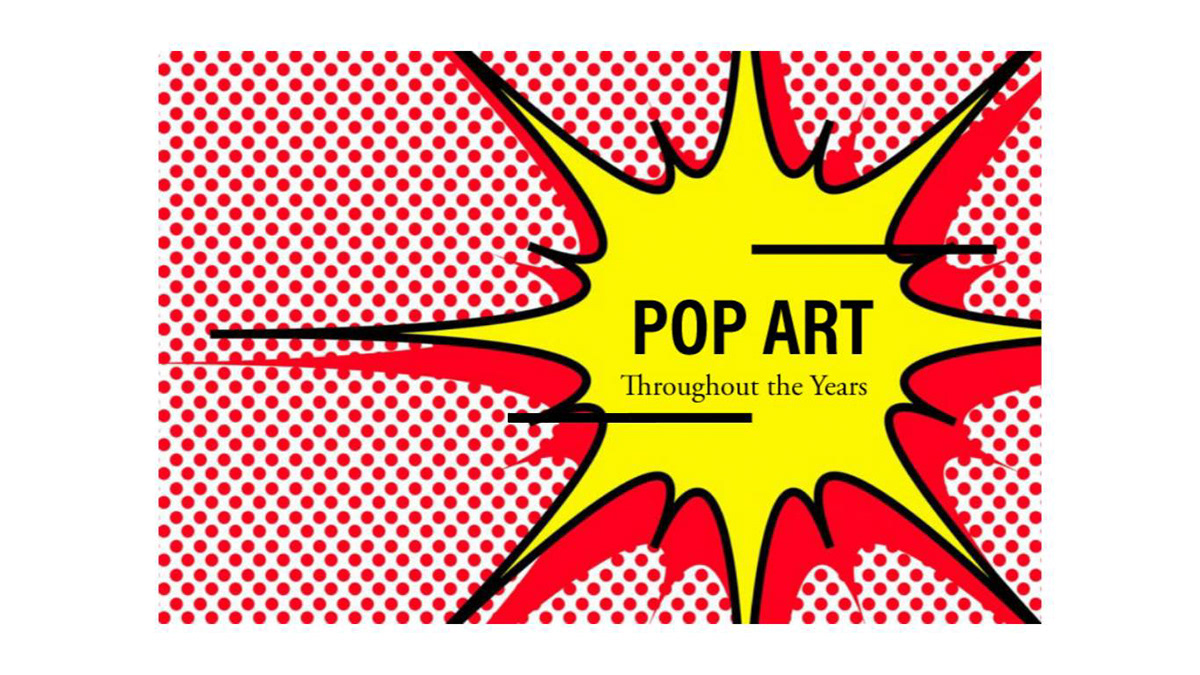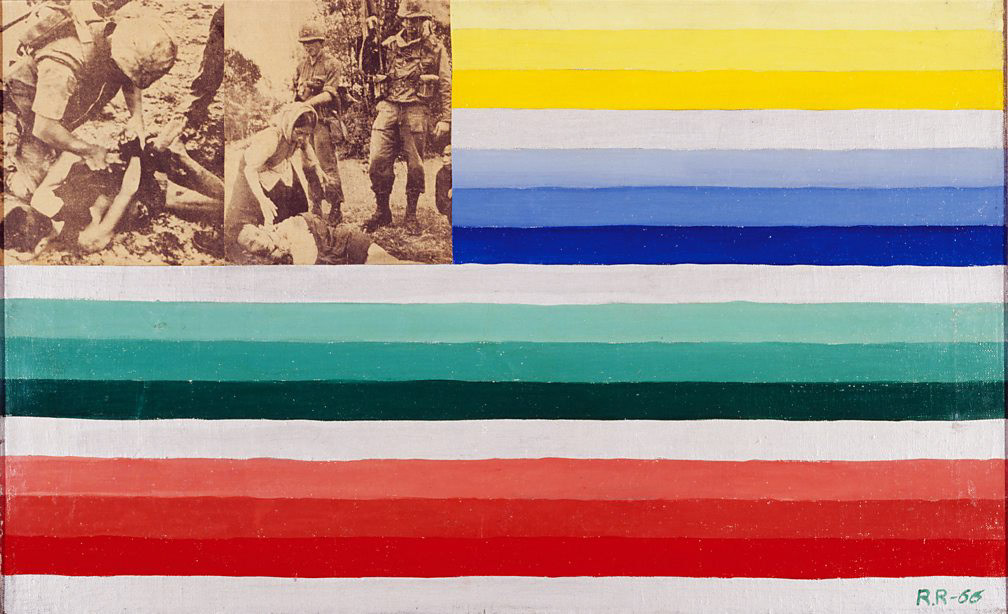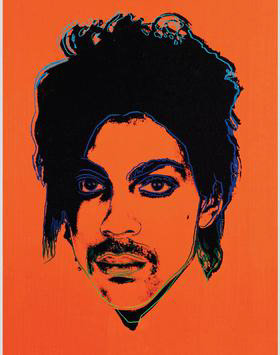
What is Pop Art?
The Art Movement Pop Art began in the 1950’s in London, the United Kingdom. The movement wanted to establish the idea that art can come from any origin, it was a new and reachable way of creating modern art. The movement is called ‘Pop Art’ due to its influence from Popular Culture, and Mass Media. Artists that worked with the style created art from Comic Book style, Newspapers, Advertising, to Commercial Products, Common and Cultural Objects, Portraits, Movies, Music, and Celebrities. Even though Pop Art had its origins in London, it was heavily influenced by American Mass Media.
Development and Influences:
The independent Group who are the creators of Pop Art, started the movement in 1952 in London the United Kingdom. The group included Eduardo Paolozzi, a visual artist of several medias, Richard Hamiltion a painter and collage artist, William Turnbull, a sculptor, Nigel Henderson, a photographer, and Lawrence Alloway an art critic. They met at the Institute of Contemporary Art in London, where they would start creating collages and paintings, however these weren’t the first piece of Pop Art, the style can be seen in Gerald Murphy's, and Charles Demuth who’s work started in the 1920’s, and included many aspects of commercial placement. Eduardo Palozzi produced what is considered the first true artwork of the Pop Art Movement ‘A was a rich man’s plaything’ 1947, which features the word ‘Pop’ appearing out of a gun. The aim behind The Independent group was to challenge the current artistic way and focus on more of a modern style, this was done by taking cultural or everyday objects and creating art from them, just as they are with no further signalization's or see them through a different light. ‘Proto - Pop Art’ was already established in Europe during the 1940’s however The Independent Group would go on to create what would eventually become named ‘Pop Art’ and create some of the first examples of Pop Art with the first exhibitions that would include large amounts of Pop Art pieces, which would go on to become classics of the Movement and would greatly influence the work of one of them most recognised and fellow Pop Artists Andy Warhol. In 1956 The Independent Group disbanded however many of the artists continued to meet, with several featuring in exhibition ‘This Is Tomorrow’. Richard Hamiltion’s collage ‘Just what is it that makes today’s homes so different, so appealing?’ was displayed this piece would later be one of the turning pieces in the movement and is one of the earliest true Pop Art pieces. Lawrence Alloway wrote an essay about Pop Art in 1958 ‘The Arts and Mass Media’ this helped popularise the art movement.

’I was a rich man’s plaything’ - Eduardo Palozzi’s 1947

‘This is Tomorrow’ Exhibition leaflet - 1956

‘Just what is it that makes today’s homes so different, so appealing?’ Richard Hamiltion-1956

Andy Warhol:
Andy Warhol an American Painter, Filmmaker, and Print maker born in Pittsburgh Pennsylvania on the 6th of August 1928. He attended School at Holmes School and took free art classes at the Carnegie Institute before attending Schenley High School in 1942. His father recognised his talents and saved money so he could further his education at college, Warhol went on to attend Carnegie Institute of Technology from 1945 till 1949. After graduating with a degree in Pictorial Design he moved to New York City to follow a career in commercial arts. Warhol was the most successful and highly paid commercial illustrator in New York before he began his work for galleries and work in Pop Art.
In 1960 Warhol turned to the Art Movement, Pop Art where in the following year he started making paintings inspired by the movement, his ‘Coca-Cola 2’ was a central piece to his start of a very successful career in the creative industry. He began to create Photographic Silkscreens, this allowed him to create art work quickly and easily to be reproduced. Working on a large series of celebrity portraits featuring Marilyn Monroe, Elvis Presley, and Elizabeth Taylor. In 1962 he created his series ‘Campbell’s Soup Cans’ which exhibited in his first solo exhibition which was held in the Ferus Gallery Los Angeles. In 1969 he co-founded ‘Interview’ with British journalist John Wilcock, a magazine which focused on film, fashion, and pop culture, this gave him easy access to the stars, who he loved creating Art Work of. His name will always be the most affiliated with Pop Art. I created a questionnaire asking people about Pop Art. I asked numerous questions to do with Pop Art, with one of them being ‘Name Pop Artists you know of?’ Andy Warhol's name was the most recorded name with everyone who participated in the questionnaire answering with his name. Also asked was ‘Who is your favourite Pop Artist?’ Andy Warhol also topped this question with 80% answering with Warhol being their favourite. Andy Warhol continued making Art nine months before his death he created a series of self-portraits on canvases, with some of the canvases measuring nine feet square. Warhol died on the 22nd of February 1987 due to complications following a surgery. He continues to be a household name, with a successful career, iconic artwork, a pioneer in the Pop Art Movement, and legendary statues, Warhol will always be an icon.

’Coca-Cola 2’ Andy Warhol - 1961

‘Campell’s Soup Cans’ Andy Warhol - 1962

’Interview’ Magazine co-founded by Andy Warhol and John Wilcock in 1969
Social, Political, and World Events:
In the United States Pop Art came from a rebellion against Abstract Expressionism, that was considered by Pop Artists as pretentious; it was a return to composition and representational art.
European Pop Artists were far more political than the American or British artists. While other artists were focusing on celebrities and mass media, European Artists and other Artists from around the world addressed American militarism. Raimo Reinikainen subverted the star spangled banner with photos of the American atrocities in Vietnam, he did this as a series of 4 art pieces, named ‘Sketch for the U.S. Flag 1, 2, 3, 4’ they are heavily anti-war pop art works representative of his political views in the mid-1960s.

‘Sketch 3 for the U.S. Flag’ Raimo Reinikainen - 1966

’Sketch for the U.S. Flag 1, 2, 3, 4’ Raimo Reinikainen - 1966
Brazlian Artist Marcello Nitsche created a large paper mache hand that speaks out against the military regime. Speaking to the Tate in 2015 he said this about his piece ‘’In the work entitled I Want You the visual language was based on the American propaganda poster of the time bearing the words ‘I want you for the US army’. The work entitled Kill Fly was a reference to dictatorship; it was the camouflaged way I found to speak out against the military regime’’

‘I Want You’ Marcello Nitsche -1966
Andy Warhol created a series of 11 screen prints portraying the media’s portrayal of President John F. Kennedy's assassination on November 22nd, 1963. The title for the series derives from the phrase “news flash”. The prints come from campaign posters, mass media photos, and advertisements.
Flash-November 22 1963 Series, 1968









Pop Art can be seen as a Social Movement, it influences people’s lives not only through the world of Art, but also through the world of advertising. Advertising and branding became influenced by Pop Art ironically as Pop Art had originally drawn inspiration from advertising and mass media. We can see pop art’s influence in the minimalism of Apple’s branding in their advert for their ipods.

Pop Art can also be seen in the world of fashion. Yayoi Kusama is known for her polka dot prints, Kusama has worked with a variety of media throughout her career, including painting, collage, sculpture, performance art. In 2012 the French fashion house Louis Vuitton collaborated with Kusama giving her a platform in the fashion world with a collaboration of handbags and accessories, which took over the brand's stores worldwide. Many other Fashion brands have collaborated or taken inspiration from artists such as Iceberg’s collab with Roy Litchenstien where they used his iconic comic book look to create fashion pieces, or Philip Colbert dress designs taken from Andy Warhol, Salvador Dali’s and Duchamp’s R. Mutt.

Yayoi Kusama collaboration with Louis Vuitton

Iceberg's collection inspired Roy Litchenstien

Philip Colbert Warhol’s soup cans, Salvador Dali’s lobster phone and Duchamp’s R. Mutt urinals.
Characteristics:
Some characteristics of Pop Art and arguably the most identifiable is subject choice, most Pop Art Artists used recognisable imagery such as everyday items and icons, popular celebrities of that time. Another popular characteristic of Pop Art is the use of bright colours, a lot of Pop Artists used the primary colour pallet, which are reds, yellows, and blues, these colours were prominent in Roy Lichtenstein's work. Irony and Humour were also a big component of the movement, sometimes used to make a statement about events happening at that current time.

‘In the Car’ Roy Lichtenstein - 1963
Techniques and Technologies:
Many Pop Artists used the techniques of the Printmaking Process, which allowed artists to create and reproduce their art quickly and in large amounts. Most Pop Artists often created through the form of Screen Printing, Andy Warhol used this technique, where ink is transferred through a mesh screen and onto a substrate or material of the artist choice. Wherever other artists such as Roy Litchenstein used the printing process of Lithography, or printing through a metal plate or stone. Other Artists often blended materials and made use of a variety of different types of media such as collages or mixed media, this technique can be seen in the work of Robert Rauchenberg and Richard Hamiltion.
Other techniques were simply painting or drawing your work such as Pauline Boty’s, Rosalyn Drexlers, and David Hockney’s work. Wherever an Artist named Yayoi Kausma whose work was created during the years of peak popularity of the Pop Art Movement and continued to create Pop Art years after, created installations and 3D pieces of Pop Art.

‘The Shadow, from the Myths Series’ - Andy Warhol Screen Print 1981

‘Ready To Blossom In The Morning’ Yayoi Kusama Lithography - 1989
The Legacy of Pop Art:
70 years after the birth of the movement, we’re still celebrating pop art. It left its mark on modern artworks, design and advertising. In fashion, pop art dresses continue to inspire contemporary designers, and pop art furniture. Pop art has also influenced a lot of contemporary artists, such as Jeff Koons and Alex Katz continue putting their own spin on everyday, popular objects, many artists such as Yayoi Kusuma who created work at the peak of the movement still continue to create art with the influence of Pop Art.

Lady Gaga’s Album Artpop designed by Jeff Koons in 2013
My Thoughts on Pop Art:
I think Pop Art is one of the most influential Art Movements ever created, and even though the peak of popularity has been, I believe the movement will continue to inspire Artists for many more years. My favourite Pop Artist who I take much inspiration from in my own work is Andy Warhol, his iconic work inspires me to use colours, layers, and portraiture.
The movement of Pop Art is one i love, it’s bold, bright colours, wit, and simplicity of using everyday objects and creating art from what they see will always inspire not only me but many more artists to come.
Here are some of my favourite Pop Art pieces:

‘Chubby Checker’ Rosalyn Drexter -1964

’Orange Prince’ Andy Warhol -1984

’Mushrooms’ Yayoi Kusama -1995

‘Interior II’ Richard Hamiltion - 1964

‘Portrait of Maurice’ Andy Warhol - 1976
References:
My Modern Met.com
Invaluable.com
Pop Art History.com
Wikipedia
Technology Student.com
BBC.CO.UK
Tate.org.uk
We Heart.com
Widewalls.com
The Art Story.org
Andy Warhol.org
Survey Monkey.com
History of Pop Art.onmason.com
Andy Warhol Documentary Youtube.com

